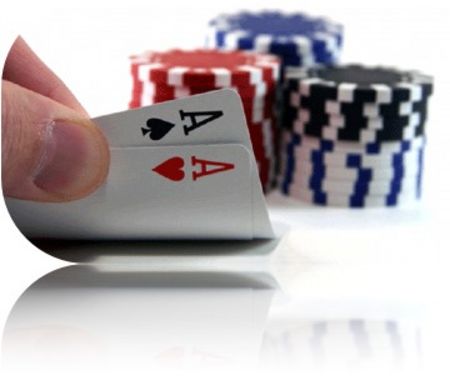Flush Draws

Strategies for flush draws with a three-suited flop are very different than with a two-
suited flop. Strategies for two-suited flops can vary depending on other qualities of
the flop. For example, the flop could also have a pair or connected cards. Flush
draws increase in value when you add other elements to your hand such as straight
draws, pairs, or overcards.
Let's look quickly at odds. Flush draws are approximately 2 to 1 against improving
by the river, but this could improve depending on the pair and straight possibilities
of your hand. Add a gut-shot straight draw or an over-card and you are about 1.2 to
1 against improving. An open-ended straight and flush draw is .9 to 1. Add
overcards to any of these and you have even better odds. As you can see. at worst
you are 2 to 1 against improving, and this is even better when you have other
elements to your hand.
Two-Suited
Let's look first at flush draws when the flop is two-suited. When the flop is two-
suited, you are almost always getting sufficient odds to draw to the flush with these
few exceptions:
-
You are heads up in a small pot and don't have a pair, and you are confident
that your opponent has a pair higher than your two cards.
- There is a pair on the flop and a decent chance an opponent holds trips. With
a pair on the flop, it is much easier for someone to hit a full house to beat
your flush; however, you can still draw sometimes depending on the action
and size of the pot.
- The action is so strong on the flop that your small flush draw could be
drawing dead to a higher flush draw. Be careful in getting into a betting war
with a drawing hand that could be second-best. The worst case scenario is
when someone has a set and the other player has a nut flush draw with a top
pair. These two players could be raising a lot and you would be stuck in the
middle drawing dead. Play your draws, but be prepared to back off when the
action gets too heavy on the flop.
Flush draws are very strong. Even with the exceptions listed above, there may be
times when drawing to the flush is still OK. For example, if the pot is large with
several opponents, sometimes you can draw to the nut flush when there is a pair on
the flop.
Let's look first at draws when there are three or more players in the hand. In these
cases, you usually prefer to keep as many players in the hand as possible to help
improve your odds: therefore, you should normally check when acting first,
especially when there is a preflop raiser. You do not want to bet and then get raised
immediately behind you, causing the other players to fold. If you were the preflop
raiser, go ahead and bet out as usual. If some-one bets into you and there are still
opponents to act behind you, normally just call to allow the other players to come in
cheaply.
There is one exception in trying to keep as many opponents in the hand as possible
with your flush draws. This occurs when there is a large pot and you have other
elements to your hand that could help you win the pot. For example, if you have an
ace overcard with a weak kicker and you believe a raise could get an opponent to
fold a hand like Ax, you might raise to give yourself a better chance at winning a
large pot. Generally, deciding whether to drive out players or keep them in the hand
is a function of the size of the pot and how strong your secondary draws are.
If there are already several callers, raising is an option. Raising increases the size
of the pot when you are getting good pot odds on the bet. If you are in late position,
you also might be able to get a free card on the turn. Check-raising is an option
when there are several callers in the hand, but you must act first on the turn thereby
eliminating your chance at a free card. Check-raising in these situations is much
better when you have other strong elements to your hand, such as a pair, two
overcards, or a straight draw.
Against one or two opponents (and sometimes even three), it is possible to win the
pot on a semi-bluff. Whenever you feel there is a chance to win the pot outright by
betting or raising, you should usually do so.
Advanced Concept; Whenever you have a strong drawing hand, you should bet or raise if you feel
you have a decent chance to win the pot outright, especially against one or two opponents.
Semi-bluffs with flush draws are very strong plays. You could win the pot
immediately, and if you don't, you still have a good chance at winning the pot on
your draw; therefore, if you act first against one or two opponents, usually bet out if
you feel you have some chance that your opponents will fold. Otherwise, usually it
is better to just check and call.
If someone bets and you feel there is some chance he is bluffing, semi-bluff raising
can be correct. If you act last and no one has bet, you should almost always bet
out. If both players have already bet, you must decide whether to raise or just call.
Raising is an option if you could receive a free card. Otherwise, only raise when you
have other elements to your hand.
There are times when reraising with flush draws is correct. For example, a hand like
Q
♦ J
♦ with a flop of T ♣
9
♦ 5
♦ gives you a super strong hand. You have a good flush
draw for nine outs, an open-ended straight draw for an additional six outs, and
finally a queen or jack may also give you the winner for an additional six outs. You
will hit a straight or flush 54% of the time and an overcard an additional 24% of the
time! Heads up you should almost always reraise with hands such as these.
Against several opponents, always reraise unless you prefer to just call rather than
drive out opponents who might have to pay two bets. With small pots, you prefer
there to be several opponents in the hand; however, if the pot is large, you might try
to drive out opponents if one of your overcards could potentially win the pot.
NEXT...Three-Suited

